Electronic notebook Citizen RX-9600
Parsing a shelf with things that, in fact, are no longer needed, an electronic notebook Citizen RX-9600 was found. If I understand correctly, the book is one of the last representatives of the family, let’s say, of classic books. She had on board as much as 128 KB of memory. The exact date of production is not known, but the book is already from the 2000s. When turned on, she reset the date to 01/01/2001.
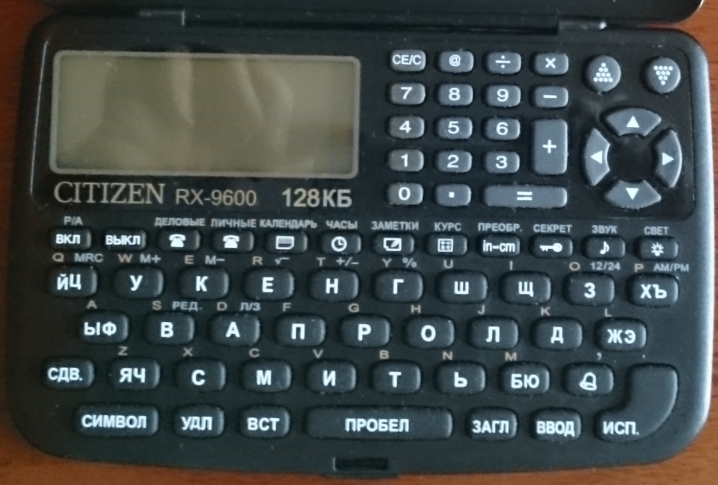
Attention: there are a lot of images under the cat!
I’ll start the review, perhaps, from the beginning. More precisely, from the appearance of the device.
The device is pretty nice to hold. When closed, its dimensions are quite comparable to the sizes of modern smartphones. For example, it is about 1 cm longer, 2 cm wider and 2-3 mm thicker than the Sony Xperia Z3 Compact.
At the top we see a simply closed cover, on which the model name and memory capacity are

flaunted : At the bottom we see two battery covers and a mechanical three-position switch between them. In the middle position, the covers are locked, moving the switch to one side, unlock the opposite cover. Having removed one cover, nothing prevents moving the switch in the opposite direction and removing the other. The idea of alternating batteries is caused by the fact that the book lacks non-volatile memory. If the book is de-energized, all 128 KB of data is lost. And this is its huge drawback, because you can’t copy information in any way, and forgetting to change the batteries on time is easy. Nearby is the Reset button.
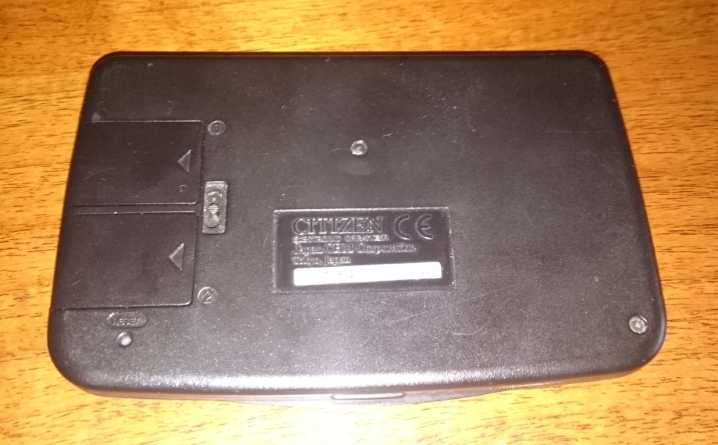
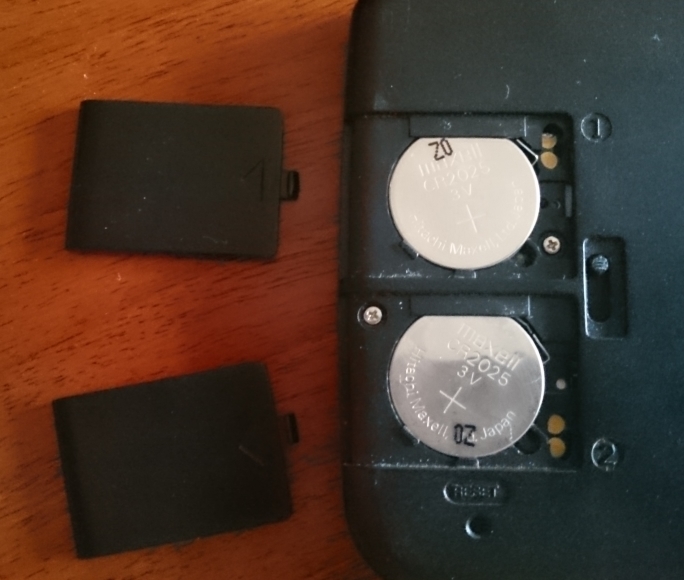
On the side faces, there is little interesting, in fact, only the mechanical button for locking the front opening and the hinge for fastening the cover at the back:




Open the book. Above is a brief instruction, below - the actual display, keyboard, and electronics unit under all of this:
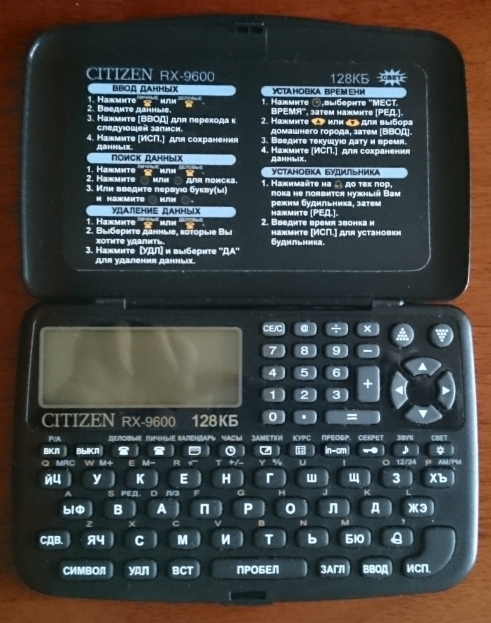
qwerty / yutsuken keyboard layout. The keyboard is not quite full: the letters Y and C, Y and F, X and Kommersant, Zh and E are located occupy one key (in pairs), the second letter is selected with the "shift" key
The first inclusion is performed using the reset button. Immediately we get into the "Clock" mode:
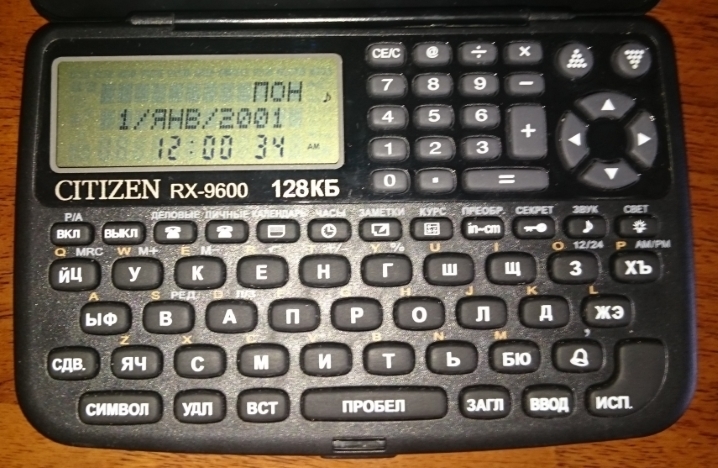
Time, date and time zone setting are performed after pressing the “Red” button (Combined with buttons (In Russian and S English). Time zones in the book, of course, as of the date of writing the firmware. You can choose between 12/24 time display solutions The book accepted the current date without any problems:
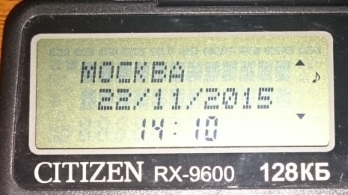
Now, actually, about the functionality. There are two sections in the book called notebooks - business and personal, calendar / diary / birthday reminders (on one button), notes, currency exchange converter, conversion major led Ichin. All sections that allow recording information have their own doubles, access to which is closed with a password (secret button), and we see either unclosed content or closed content.
The notebook allows you to enter the following information: Name, Address, Phone, Fax, Website, E-mail. The sign of the dog looks quite specific, a feature of low screen resolution.
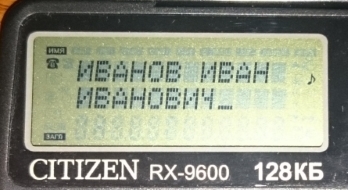




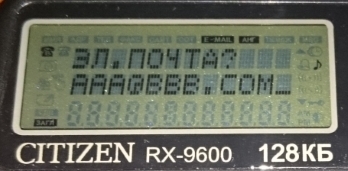
You can scroll through the entries in the order. A search by first letter is also provided.
The course converter is pretty simple. You set the course, enter the amount and use the left / right buttons to select the direction of translation. There are only three currency pairs: $ - rub, Dem - rub, EURO - $.
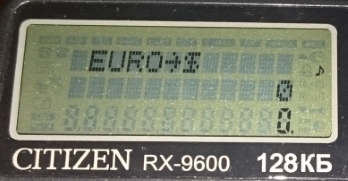
The value converter is similarly made, only the choice is larger. Of course, the conversion factor does not change. The pairs are as follows: inch - cm, foot - meter, yard - meter, mile - km, acre - sq. Meter, acre - ha, acre - sq. Ft., Sq. M. - sq. Ft., F - C, pint - l , am.gallon - l, br.gallon - l, ounce - ml, fluid ounce - ml, pint - ounce, ounce - pound, ounce - g, pound - kg, cal - joule, hp - kV, metric hp - kV (spelling and punctuation saved).

There is a backlight. We managed to photograph the result of the backlight only with the flash turned off.
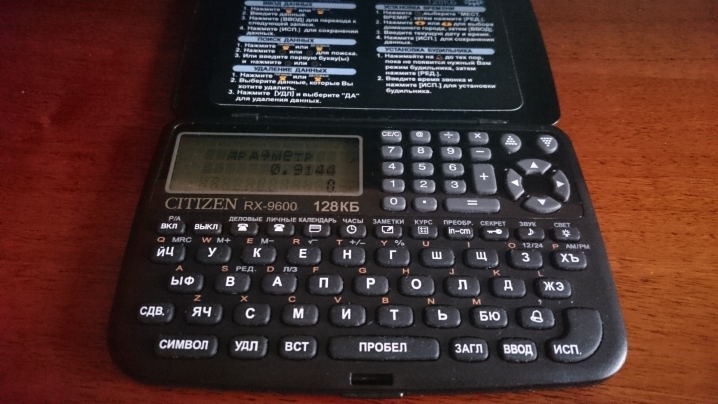
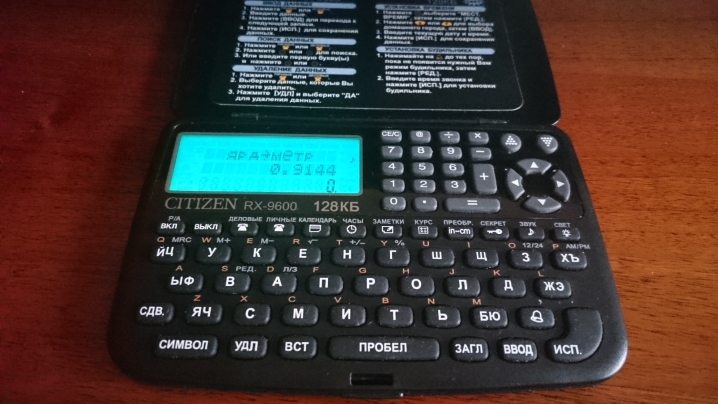
Password. Six characters maximum, letters and numbers are possible. After entering the password, everything is the same, only the memory areas are different, disjoint, so to speak.
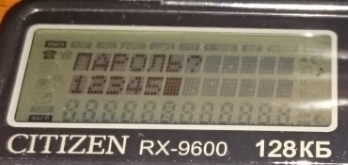
What I want to say in the conclusion of this note is its attitude to this piece of iron. The piece of iron is very pleasant in the hands. There is nothing to synchronize with it, which means that information can be stolen from it in only one way - by physically stealing a book. It's hard to say anything about the cracking resistance of password protection. Using the keyboard, you can access sensitive information only by entering a password. Of course, there are a lot of password options - busting is practically not possible. On the other hand, information is unlikely to be encrypted, so if you set a goal, you will probably get access to it at the iron level. Unless, of course, it will be possible to disassemble without disconnecting power. For me, this is the case for paranoids of moderate severity. I myself would not refuse to write down some things in it, for example, passwords. Unfortunately, its main drawback - the loss of information as a result of a depleted battery - eliminates this advantage. As a result, this book was never actually used by me for its main purpose.
PS: To be honest, I would buy a similar, more modern toy, devoid of this drawback, and, possibly, with the function of backing up information. However, as far as I understand, electronic notebooks are now completely extinct. For me, it looks rather strange, considering that electronic translators continue to live. Despite the fact that almost ten years ago, the PDA with lingua was engaged in such a translator in all respects.
Attention: there are a lot of images under the cat!
I’ll start the review, perhaps, from the beginning. More precisely, from the appearance of the device.
The device is pretty nice to hold. When closed, its dimensions are quite comparable to the sizes of modern smartphones. For example, it is about 1 cm longer, 2 cm wider and 2-3 mm thicker than the Sony Xperia Z3 Compact.
At the top we see a simply closed cover, on which the model name and memory capacity are
flaunted : At the bottom we see two battery covers and a mechanical three-position switch between them. In the middle position, the covers are locked, moving the switch to one side, unlock the opposite cover. Having removed one cover, nothing prevents moving the switch in the opposite direction and removing the other. The idea of alternating batteries is caused by the fact that the book lacks non-volatile memory. If the book is de-energized, all 128 KB of data is lost. And this is its huge drawback, because you can’t copy information in any way, and forgetting to change the batteries on time is easy. Nearby is the Reset button.
On the side faces, there is little interesting, in fact, only the mechanical button for locking the front opening and the hinge for fastening the cover at the back:
Open the book. Above is a brief instruction, below - the actual display, keyboard, and electronics unit under all of this:
qwerty / yutsuken keyboard layout. The keyboard is not quite full: the letters Y and C, Y and F, X and Kommersant, Zh and E are located occupy one key (in pairs), the second letter is selected with the "shift" key
The first inclusion is performed using the reset button. Immediately we get into the "Clock" mode:
Time, date and time zone setting are performed after pressing the “Red” button (Combined with buttons (In Russian and S English). Time zones in the book, of course, as of the date of writing the firmware. You can choose between 12/24 time display solutions The book accepted the current date without any problems:
Now, actually, about the functionality. There are two sections in the book called notebooks - business and personal, calendar / diary / birthday reminders (on one button), notes, currency exchange converter, conversion major led Ichin. All sections that allow recording information have their own doubles, access to which is closed with a password (secret button), and we see either unclosed content or closed content.
The notebook allows you to enter the following information: Name, Address, Phone, Fax, Website, E-mail. The sign of the dog looks quite specific, a feature of low screen resolution.
You can scroll through the entries in the order. A search by first letter is also provided.
The course converter is pretty simple. You set the course, enter the amount and use the left / right buttons to select the direction of translation. There are only three currency pairs: $ - rub, Dem - rub, EURO - $.
The value converter is similarly made, only the choice is larger. Of course, the conversion factor does not change. The pairs are as follows: inch - cm, foot - meter, yard - meter, mile - km, acre - sq. Meter, acre - ha, acre - sq. Ft., Sq. M. - sq. Ft., F - C, pint - l , am.gallon - l, br.gallon - l, ounce - ml, fluid ounce - ml, pint - ounce, ounce - pound, ounce - g, pound - kg, cal - joule, hp - kV, metric hp - kV (spelling and punctuation saved).
There is a backlight. We managed to photograph the result of the backlight only with the flash turned off.
Password. Six characters maximum, letters and numbers are possible. After entering the password, everything is the same, only the memory areas are different, disjoint, so to speak.
What I want to say in the conclusion of this note is its attitude to this piece of iron. The piece of iron is very pleasant in the hands. There is nothing to synchronize with it, which means that information can be stolen from it in only one way - by physically stealing a book. It's hard to say anything about the cracking resistance of password protection. Using the keyboard, you can access sensitive information only by entering a password. Of course, there are a lot of password options - busting is practically not possible. On the other hand, information is unlikely to be encrypted, so if you set a goal, you will probably get access to it at the iron level. Unless, of course, it will be possible to disassemble without disconnecting power. For me, this is the case for paranoids of moderate severity. I myself would not refuse to write down some things in it, for example, passwords. Unfortunately, its main drawback - the loss of information as a result of a depleted battery - eliminates this advantage. As a result, this book was never actually used by me for its main purpose.
PS: To be honest, I would buy a similar, more modern toy, devoid of this drawback, and, possibly, with the function of backing up information. However, as far as I understand, electronic notebooks are now completely extinct. For me, it looks rather strange, considering that electronic translators continue to live. Despite the fact that almost ten years ago, the PDA with lingua was engaged in such a translator in all respects.
